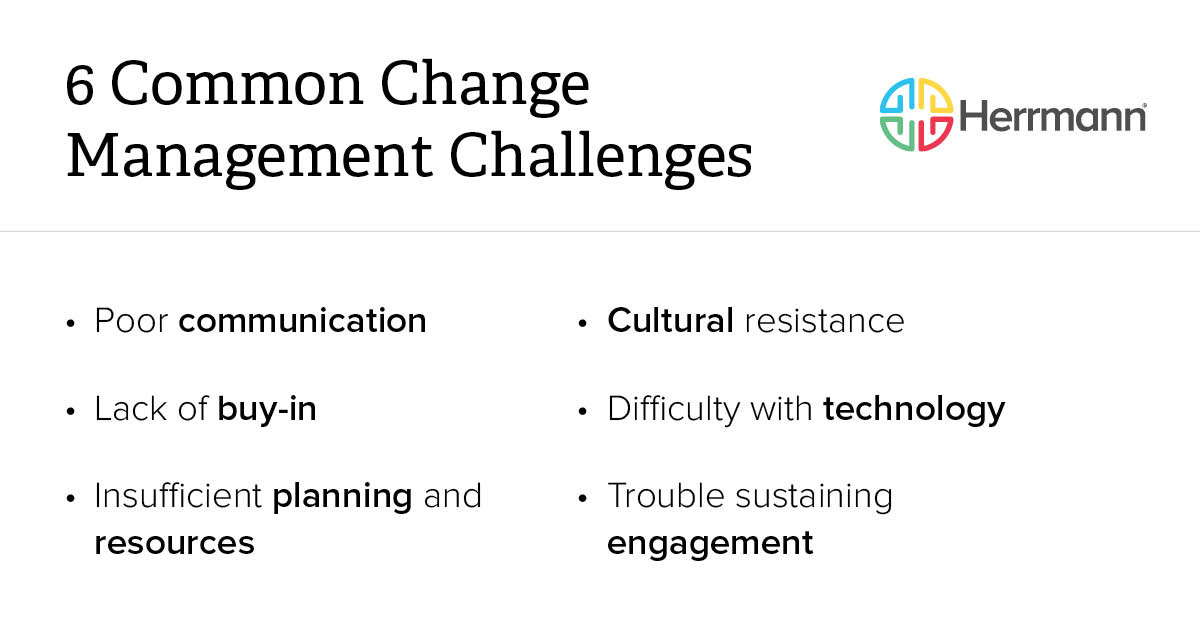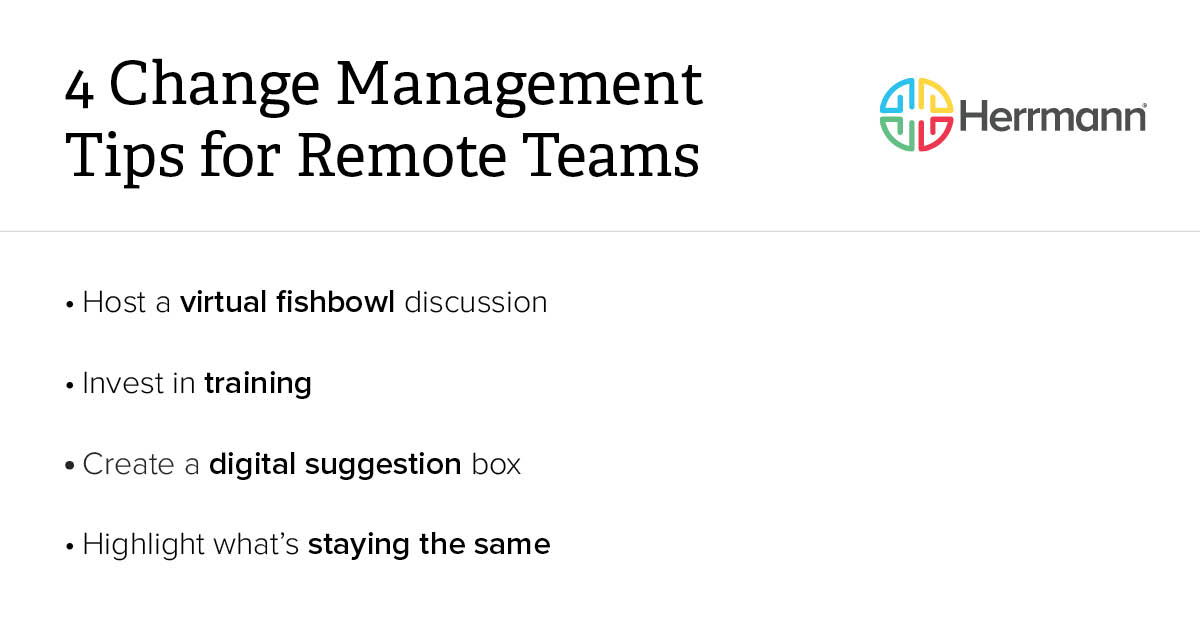The workplace has changed dramatically in just a few years. Millions of people have shifted to hybrid and remote schedules while new technologies continue to change how work is done. All of this disruption puts stress on organizations and the people in them. As they look to adapt to the future of work, leaders must pay particular attention to change management in remote working.
Change management was already difficult in old-school corporations with hierarchical structures, centralized offices and relatively stable technology. While the adage “70% of change initiatives fail” is impossible to prove, anyone who’s spent much time in large organizations knows about spectacular change efforts that failed to deliver.
Change management in virtual environments comes with its own challenges, particularly if the culture is already struggling to support remote workers. Let’s look deeper at the common challenges of change management, how remote change management complicates matters and four ways to make the process easier for your virtual team.
What Is Change Management?
Change management describes all the activities within an organization — from planning to implementation and follow-up — that lead to new or adjusted processes. While change can occur organically, change management describes a structured approach that covers the full range of stages, including documentation, communication, project management and post-change assessment.
6 Common Challenges of Change Management With Remote Work
Change management initiatives require tremendous time, attention, organization, communication and resources. Failing in any of these areas can hinder the entire effort. And even when you get all the logistics right, you still need buy-in from your leadership, managers, line employees and other affected stakeholders.
With that in mind, let’s look at six common obstacles that are especially relevant for leaders trying to guide remote teams through change efforts.
Poor Communication
Change can be hard to accept and understand, much less accomplish. When employees hear about a change effort that affects them, they’re understandably curious: What’s changing? Why is it changing? What’s my role in this? Will this be bad for me (or the team, the company, etc.)?
It’s understandable for employees to be skeptical, worried or even fearful of change. Leadership needs to help employees shift their mindset and begin to see the potential for change. When employees understand what is changing, why it’s occurring and what better future will emerge, they can start to imagine that future and their role within it.
Be realistic, of course. If layoffs are inherently part of a transformation, you shouldn’t say, “No one will lose their jobs.” Being realistic also means acknowledging that employees might not be as happy about change as you. A CEO introducing herself to a newly acquired company might want to launch into their exciting plans. But they might be better off starting with a statement acknowledging employee discomfort — namely, that the acquired employees chose to work for one employer and now must work for another.
Your communication should also emphasize what isn’t changing. Even the biggest transformations usually leave many processes, traditions and behaviors intact. By laying out what is and isn’t changing, employees can begin to find certainty amid uncertainty.
Communication is a two-way street, especially in the early stages of change. Make sure employees have multiple forums for communicating their questions and concerns. That might include town halls, team meetings, online forms or an FAQ, depending on the need and the type of question. Team leaders should offer their employees an open mind and a bent ear, seeking to listen first and then provide support.
Lack of Support or Buy-In
Change can be unfamiliar, mysterious and nerve-wracking. And people will want to exercise their autonomy to avoid change. That’s why buy-in is so critical at all levels of the company.
Sign up to our newsletter for the latest insights
Middle managers might be the most important layer of buy-in for change management. They’re leaders who can either facilitate or block changes because of their operational authority. They’re also much like employees, wondering whether the change initiative is a good idea and whether it will hurt their careers. Change consultant Wendy Hirsch describes the middle manager’s three stages as “interpret,” “engage and explain,” and “coordinate and execute.”
The “interpret” stage is fundamental, as it is when middle managers assess how the change will affect them and whether that’s a good thing. When middle managers have the information and reassurance they need, they’re more likely to support change initiatives down the line. The key to employee buy-in, in many cases, is manager buy-in.
Lack of Planning or Resources
Change management is less of an event and more of a process. Change can’t happen without a road map identifying “who, what, where, when, why and how.”
A poorly constructed plan results in miscommunication, lack of direction, missing or duplicated work, and a lack of confidence among employees who can’t figure out what they should be doing.
Resources are also essential, which ties back to the C-suite and board-level buy-in that change teams need. Organizational change requires money, dedicated employees and the authority to reassign teams, assets and tasks to support the goal. One of the easiest ways to starve a change initiative is to deny it resources.
Cultural Resistance
Your culture affects all of the above. Organizations with poor cultures are less likely to have the trust needed to build buy-in, as trust is low. Poor cultures are more likely to be siloed, making coordination and communication more difficult. These cultures likely have less engaged managers with lower-performing teams that are less capable of executing.
Resistance doesn’t always doom organizational change through outright rebellion, but by slowly grinding down the change effort. You’ll encounter resistance at every stage: securing buy-in, getting budget and resources, compelling teams to work together and rallying employees to support the change effort. Too much resistance leads to poor results, reinforcing organizational apathy — “See? This change idea doesn’t work!”
Difficulty with Technology
Enterprises already juggle endless platforms and logins, and that’s before getting into the specialized tools used within departments and teams. Change management initiatives create disruption here, either by overhauling the technology being used or by streamlining it. Either way, employees must adjust to new tech and ways of working.
This effort is complicated when you buy technology or design processes without considering remote employees. For example, your organization moves to a new workforce management system, but your team members can only access this platform while on the company’s networks. Remote employees can’t log in and get the crucial information they need.
Perhaps your organization is overhauling its approach to projects by emphasizing team meetings at a key stage. Everyone agrees those meetings should happen in designated conference rooms. Unfortunately, those rooms don’t stream video, so remote employees can’t fully participate.
Those are just two of the many ways technological changes can be exclusionary or create roadblocks for remote employees, especially those on teams with a mix of in-office and remote people.
Trouble Sustaining Engagement
Building and sustaining employee trust is an ongoing responsibility, whether it’s employee trust in their co-workers, managers or executive leadership. Trust can be more difficult to measure and grow with remote teams if employees feel disconnected or don’t have regular interaction with their colleagues.
Managers of remote employees can also dampen engagement if they don’t trust their employees. These managers favor on-site employees and believe in negative stereotypes about the remote workforce.
During change management initiatives, remote employees must be looped into key communications and be able to access all documentation. Don’t rely on word of mouth to communicate important information. That creates miscommunication and errors and reduces engagement as remote employees realize they’re out of the loop. They’ll feel like outsiders on their own teams and are more likely to resist change out of frustration.

4 Ways to Support Change Management in Remote Workplaces
Effective change management initiatives require managers to commit personally and get their teams excited about the changes. This is especially important for remote teams, who rely on their managers for communication, training, resources and inspiration.
The Whole Brain® Thinking framework can help here by encouraging strong habits around team thinking and cognitive diversity. Change management isn’t just about changing structures, processes and technology, but also about your workforce’s mindset.
Here are four ways leaders can empower their remote teams.
Host a Virtual Fishbowl Discussion
A popular change management exercise is the fishbowl discussion, which can occur in person or remotely. A virtual fishbowl discussion is an open dialogue where stakeholders have inclusive, transparent conversations guided by moderators. These conversations involve a maximum of four to five participants at a time. Each discussion is short and ends with a follow-up question to spur subsequent discussion.
This format highlights expert insights while making it easier for all participants to speak up about changes. From a Whole Brain® perspective, a virtual fishbowl discussion might begin by addressing these changes’ emotional (Red) aspects so everyone knows their concerns are understood. Then, the discussion can move into tactical, logical and fact-based (Blue) topics.
Fishbowl discussions are designed to solicit high contribution levels regardless of the setting. In a virtual team, they can level the playing field for remote employees who might feel left out by, say, an in-person brainstorming session where they are on speaker or video.
Invest in Training
Your organization’s change management initiative probably means your employees will have to learn new ways of working — maybe even new job roles. One of the easiest ways to engage remote employees is by ensuring they have the right equipment and resources to do their jobs.
The Whole Brain® Thinking approach to employee training emphasizes a cross-training regimen and preparation, just like a fitness workout. If you want to make sure you’re meeting remote workers’ needs, start by understanding the mental demands of their jobs.
That knowledge could help you create separate training or offer different resources for remote workers that meet their role’s needs and account for their virtual presence. More broadly, instill best practices across your organization for employee training. All training should be accessible to everyone regardless of location.
When your remote team sees the investment being made in them, they’ll be better prepared and more eager to support change initiatives.
Create a Digital Suggestion Box
Even the best-planned change initiative benefits from in-the-moment feedback and ideas. Make sure your team has a central way of collecting this feedback, analyzing it and referring to it later.
Consider a digital suggestion box to collect everyone’s ideas, questions and feedback. This simple act conveys to employees that leadership welcomes their ideas, especially when they spot potential improvements. Digital suggestion boxes should allow anonymous feedback, encouraging employees to be honest without fear of retaliation or skepticism.
Suggestion boxes are just one way to practice inclusive leadership with your remote teams. And don’t forget to follow up on those suggestions, as employees will notice if their ideas are solicited but then ignored.
Highlight What’s Staying the Same
Counterbalance uncertainty with routine. Remote workers face enough distractions while working from home and can be further unsettled by the business disruption caused by change.
Even when so much is up in the air, help your people rediscover what’s constant. Whole Brain® Thinking grounds teams and individuals in understanding your mindsets and thinking preferences. That shared understanding provides remote teams with a home base even as they explore and get uncomfortable with the changes occurring.
What stays constant during transformational change? From a productivity standpoint, it could be the team’s daily processes and habits that power their best work. From a cultural perspective, your company’s values serve as a North Star even in the most uncertain moments.

Improving Virtual Change Management
Change management helps organizations transform themselves for a better future. Every leader is responsible for leading their teams through these challenging moments while fostering a transparent, inclusive and collaborative environment.
Many leaders are still learning to navigate change management in remote working. Savvy remote leaders understand that remote workers want to feel valued, connected and informed. Integrating remote teams and their ideas into your change initiatives increases the likelihood of transformational success and a happier, more engaged workforce.












